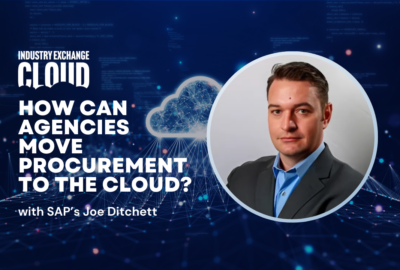Insight by Pluralsight
Industry Exchange Cloud 2023: Pluralsight’s Drew Firment on why AI and cloud computing pair well together
Increasingly, AI will be available on demand: “You’re going to see more of those services really built into the cloud, making it much easier for folks that ...
Artificial intelligence is starting to take hold in the federal government — to the point where it’s joining forces with other disruptive technologies like cloud computing and containerization, said Drew Firment.
The chief cloud strategist at Pluralsight went so far as to suggest that 2024 might be the year of AI.
And there’s plenty of potential for taking advantage of both AI and cloud in tandem, Firment said during at Federal News Network’s Industry Exchange Cloud 2023.
That said he also cautioned federal IT and program staffs to avoid be dazzled by technology tools and instead take a measured and planned approach to AI.
“It’s not just a matter of, ‘Hey, let’s go out there and just consume AI just as a science project,’ but rather, ‘How do we create value?’ ” Firment recommended
And one way to create value with AI is to apply it to efficient use of cloud itself, he said.
“The promise of cloud was to get rid of all the undifferentiated heavy lifting of data centers,” Firment said. “But realistically, a lot of the operations still exist with these cloud practitioners. They’re still doing a lot of undifferentiated work when it comes to cost management, architecture and things like security monitoring.”
He urged agency IT staffs to “start thinking about how you deploy AI internally, in a bit less risky environment, to start driving the efficiencies and allow cloud practitioners to focus on more valuable cloud practices. When you look at the goal of artificial intelligence, at least initially, it’s not to replace humans but really to enhance our human intelligence.”
Two ways to pair AI and cloud
Firment described two ways agencies can implement AI to augment cloud planning:
- Capacity planning for virtual machine workloads: “You want to be able to pick the right size of your virtual machines. That’s a great opportunity for AI to be able to help with the sizing of the capacity and also deprecate automatically.”
He said cloud burst capacities and load balancers are supposed to help you do that. “But how do you do it in a more intelligent way?”
- Aggregation and summary of cloud-generated logs: AI can help quickly detect logged events that require a human operator’s immediate attention and recommend specific actions. In this use case, it’s important to train the AI algorithms so that they closely align with agency cybersecurity policies.
AI can also help agencies enhance cloud deployments by improving the customer experience for citizens and the public when interacting with federal programs, Firment said.
“It could be as simple as how to make chatbots more intelligent,” he said.
Or AI might help agencies apply language models to internal policies or internal procedures, “so that when folks are interacting with you, they’re getting real answers not just listicles of your procedures,” Firment added.
Agencies could also apply AI tools internally to save the cost of operating elaborate intranets or other data repositories to provide information about cloud procedures or other policies, for instance, he said.
“Maybe there’s an internal pilot that goes in and tries to figure out how to run some AI on that — create an internal chatbot versus, back in the day, I would have said, ‘Hey, run an internal intranet site.’ ”
Prepare for governance, change management demands of AI
Firment advised agencies undertaking AI projects to think beyond cost and technology, and not overlook the organizational change implications of AI replacing other assistive systems like intranets.
“It’s going to the governance of AI, the cost associated with the maintenance of it,” he said. “Ultimately, it’s 20% technology costs, but it’s going to be 80% organizational change.”
Firment also advised not overlooking the AI capabilities offered by cloud services providers themselves. He mentioned Google Cloud Services, which is embedding AI into many of its services, and Amazon Web Services, which lets customers apply AI to code development.
“You’re going to see more of those services really built into the cloud, making it much easier for folks that are already using cloud providers to consume AI as a service,” Firment said.
He also pointed to something shared by John Willis, one of the fathers of blending development and operations (DevOps), as inspiration: Artificial intelligence “gets rid of all this stuff that he didn’t like about coding and accelerates all the things that he does like about coding.”
To discover more cloud tips and insights, visit our Industry Exchange Cloud 2024 event page.
Copyright © 2024 Federal News Network. All rights reserved. This website is not intended for users located within the European Economic Area.
Related Stories
Protected: Industry Exchange Cloud 2024: SAP’s Joe Ditchett on how agencies can move procurement to the cloud
VA approach to automated software testing is rooted in flexibility and efficiency
Featured speakers
-

Drew Firment
Chief Cloud Strategist, Pluralsight
-

Tom Temin
Host, Federal Drive, Federal News Network
Upcoming Events
Related Stories
Top Stories

Drew Firment
Chief Cloud Strategist, Pluralsight

Tom Temin
Host, Federal Drive, Federal News Network
Tom Temin has been the host of the Federal Drive since 2006 and has been reporting on technology markets for more than 30 years. Prior to joining Federal News Network, Tom was a long-serving editor-in-chief of Government Computer News and Washington Technology magazines. Tom also contributes a regular column on government information technology.






